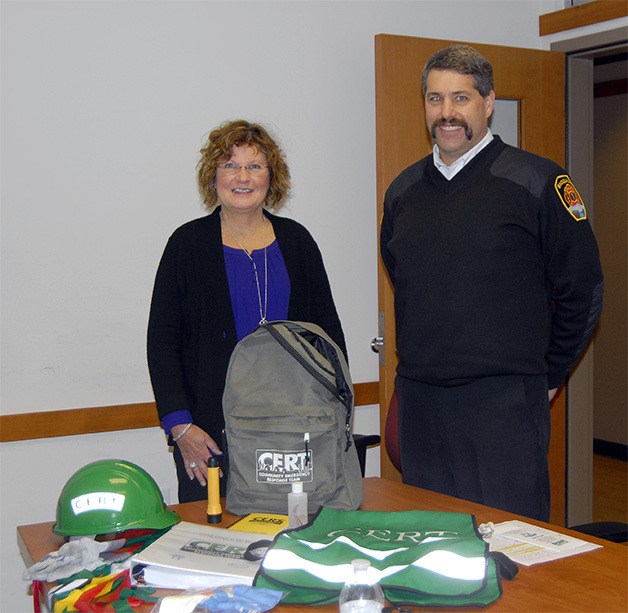People who lost power over the weekend are likely restocking their emergency supplies this week, or taking stock of their emergency plans. For the rest of us who didn’t plan ahead, there’s good news: You can always start planning now; and there are local experts who can train you in emergency planning, for a refundable $25 fee.
Community Emergency Response Team, or CERT, training is a multi-day course on disaster preparedness, first aid, fire suppression, and other skills that you’ll be glad to have in an emergency.
“We need to focus on what the most probable situations are going to be for us here in the Valley,” says Mary Norton, CERT instructor for Snoqualmie and North Bend. In order, they are flooding, followed by a significant snow event, and earthquakes.
“And who knows? Maybe a tornado!” Norton laughed. It was a joke, referring to the tornado that touched down in southern Washington late last week, but Norton also notes that tornadoes have been occurring much more frequently in the Pacific Northwest.
Norton has been a Valley resident since 2004 when she moved to the area from Southern California’s “earthquake country,” as both she and Snoqualmie Fire Chief Mark Correira call it. She had no experience with CERT before then (the organization was only created after the terrorist attacks of 2011, as part of the Federal Emergency Management Administration), but took the class here with her daughter, because, she said, she wanted to be ready.
Completing the class, she said, “created a sense of self-confidence that I would be OK, and my family would be OK, in an emergency,” she said.
She sees that same confidence emerge in each class of students she trains. So do Correira, and Fire Department administrator Liz Luizzo, who coordinate the training schedules. The final day of training is a drill, in which students go over many of the skills they’ve learned throughout the training, and after which, Correira presents their certificates of completion.
Each graduate is then considered a Level 3 CERT member, said Luizzo. Level 3, where about 10 percent of all CERT members stop their training, “is just for your own knowledge,” Luizzo explained. About 40 percent of graduates pursue training to Level 2, and 50 percent continue to Level 1, taking classes that prepare (and authorize) them for turning out to help in emergency situations.
Luizzo noted that several Level 1 CERT graduates volunteered to help with the mudslide disaster in Oso last March.
“I would assume most people go (to training) with the intention of wanting to help,” Luizzo said.
CERT training is a 36-hour commitment, with specific units covering disaster preparedness, fire suppression, and how to do triage and to give first aid. There are sessions on light search and rescue operations, disaster psychology, terrorism, and what graduates can do with their training, to benefit their communities.
The final disaster drill presents students with various challenges — all practiced with hands-on exercises in earlier class sessions — in rescuing disaster victims. Students are nervous beforehand, Norton says, but excited, and exhausted by the end.
“It is somewhat physically demanding,” Correira cautions, both in terms of the training and, depending on how far people want to pursue their training, in the expectation to respond.
Another warning, for delicate stomachs: The medical scenarios use “moulage” or special effects makeup to create realistic-looking accident victims.
“But, as they teach you in class, cover it up if it doesn’t look good,” Correira said.
The fall CERT class is underway and will end in early November. The next class scheduled is in the spring. For information about the classes, and notification of when registration opens in the spring, visit the city of Snoqualmie’s website, www.ci.snoqualmie.wa.us, and under City Departments, click Emergency Management. Citizens can also call Luizzo at (425) 888-1551.

Carol Ladwig/Staff Photo
Emergency procedures for CERT volunteers are kept on file at the Snoqualmie Fire Department.


